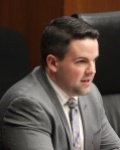By Mathew Keller RN JD, MNA Nurse Practice & Policy Specialist
In a cost-cutting move, many Minnesota hospitals are asking registered nurses to take on more pharmacy duties. Where there may have once been pharmacy staff available 24/7 to answer questions, compound pharmaceuticals, and dispense medications, many nurses are finding that such coverage is now limited to 9-5 with an outsourced pharmacist in another city (or state) available by telephone after hours to answer questions and certify prescriptions. This can lead to potentially dangerous situations for patients as well as nurses’ licenses when nurses are asked to dispense and/or compound medications in the absence of a pharmacist.
One disturbing trend we are tracking is nurses being asked to fill the Pyxis or other automatic dispensing machine on the overnight shift. Non-pharmacy staff filling a Pyxis is unacceptable pharmaceutical practice. Furthermore, it is outside the scope of RN practice.
Under state law, only pharmacists are legally qualified to dispense medications, although they may be assisted in the task by up to two pharmacy technicians at one time.[1] Dispensing is defined as “delivering one or more doses of a drug for subsequent administration to, or use by a patient.”[2] When a nurse fills a Pyxis or other automatic dispensing machine, that nurse is delivering doses of drugs for subsequent administration to a patient.
While nurses may legally administer medications, they may not legally dispense them. Filling a Pyxis is outside the scope of RN practice and can lead to discipline against one’s nursing license as well as charges of practicing pharmacy without a license. In addition to scope and licensure issues, a nurse who fills a Pyxis assumes legal liability for any and all errors or patient harm resulting from improper dispensation (e.g. putting the incorrect medication in a Pyxis drawer).
Another common issue involves nurses being asked to mix IV medications in the absence of pharmacy coverage. The propriety of this practice is situationally dependent: reconstituting medications is acceptable nursing practice; compounding medications is not. Compounding is defined as mixing, packaging, and labeling a drug for an identified individual patient’s use.[3] The determining factor in whether or not you are compounding medications is whether the medication is for immediate use or not. If a medication is being mixed for immediate use, it is acceptable reconstitution. If the medication is being mixed for storage and later use, it is unacceptable compounding.
Lastly, many nurses are being given pharmacy access for after-hours care. Under Minnesota rules[4], after-hours nurse access to the pharmacy should fulfill the following guidelines:
- Withdrawal of medications must be limited to “emergency” situations, interpreted broadly by the Board of Pharmacy to include any time a necessary medication is needed but unavailable;
- Only one designated RN on a given shift may have emergency access;
- The standard of practice is that narcotic access is limited to a locked narcotic drawer with a small supply of available medications, not full access to the narcotics safe;
- The designated RN must properly document medications removed from the pharmacy;
- The designated RN should have proper training from the pharmacy staff in pharmacy policies and procedures, as well as specific training regarding after-hours access.
MNA has and will continue to work with the Minnesota Board of Pharmacy in order to ensure that our patients are protected through proper pharmaceutical and nursing practice. Have you been asked to fill a Pyxis or compound medications? Please let us know at Mathew.keller@mnnurses.org.
[1] MN Statute §151.01 Subd. 27 (2)
[2] MN Rule 6800.7100
[3] MN Statute §151.01 Subd. 35
[4] MN Rule 6800.7530

